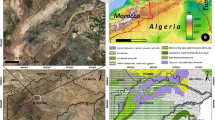Abstract
Uncertainty on the geological contacts and the block volumes of the models along boundaries is often a major part of the global uncertainty of reserve estimation. This work introduces a geostatistical technique that has been developed and tested in an iron ore deposit at Bafq mining district, in central Iran, and that, based on a probability criterion, helps to objectively model the geometry of this iron ore deposit. The main problem in reserve estimation of this ore body is its geometrical modeling and uncertainty in geological boundaries. This work deals with the geostatistical method of multiple indicator kriging, which is used to determine the real boundaries of ore body in different categories. This approach has potential to improve project performance and decrease operational risk. For this purpose, the ore body is separated into two categories including rich iron zone (w(Fe)>45%) and poor iron zone (20%<w(Fe)<45%). It significantly benefits to decrease the risk of reserve evaluation in the deposit. This case study also highlights the value of multiple indicator kriging as a tool for estimates the position of grade boundaries within the deposit. Comparison of the resultant probability maps with the real ore/waste contacts on the extracted levels shows that the first indicator model could separate the whole ore body (poor plus rich) from the waste zone by probability of more than 0.35, which concludes the total reserve of 53 million tons. The second indicator model applied to separate the rich and poor domains and the results show that the blocks with the estimated probability of equal to or more than 0.4 lay within the rich ore zone consisting of 15.8 million tons reserve.
Similar content being viewed by others
References
GOSSAGE B. The application of indicator kriging in the modeling of geological data [R]. West Perth WA Australia, Symposium on Beyond Ordinary Kriging, 1998: 40.
MARINONI O. Improving geological models using a combined ordinary-indicator kriging approach [J]. Engineering Geology, 2003, 69: 37–45.
GHOLAMNEJAD J, ANSARI A H, YARAHMADI BAFGHI A, TAQIZADEH M. Determination of ore/waste contacts by using indicator kriging, case study: Choghart iron mine of Iran [J]. International Journal of Engineering, 2010, 23: 269–276.
LARRONDO P F, DEUTSCH C V. Methodology for geostatistical model of gradational geological boundaries: Local non-stationary LMC [R]. Edmonton, AB, In Centre for Computational Geostatistics, 2004: 301.1–301.19.
ORTIZ J M, EMERY X. Estimation of mineral resources using grade domains: Critical analysis and a suggested methodology [J]. The Journal of The Southern African Institute of Mining and Metallurgy, 2005, 105: 247–256.
ORTIZ J M, EMERY X. Geostatistical estimation of mineral resources with soft geological boundaries: A comparative study [J]. The Journal of The Southern African Institute of Mining and Metallurgy, 2006, 106: 577–584.
EMERY X, ORTIZ J M, CERES A M C. Geostatistical modeling of rock type domains with spatially varying proportions: Application to a porphyry copper deposit [J]. The Journal of The Southern African Institute of Mining and Metallurgy, 2008, 108: 285–292.
CALCAGNO P, CHILES J P, COURRIOUX G, GUILLEN A. Geological modelling from field data and geological knowledge. Part I. Modelling method coupling 3D potential field interpolation and geological rules [S]. International Journal of Physics of the Earth and Planetary Interiors, 2008, 171: 147–157.
DES F, CHILÈS J P, GUILLEN A. Delineate 3D iron ore geology and resource models using the potential field method [C]//11th SAGA Biennial Techincal Meeting and Exhibition. Swaziland, 2009: 227–235.
OSTERHOLT V, HEROD O, ARVIDSON H. Regional hree-dimensional modelling of iron ore exploration targets [C]//Proceedings AusIMM Orebody Modelling and Strategic Mine Planning. Peth, 2009: 35–41.
MALLET J L. Geomodelling [M]. Oxford: Oxford University press, 2003: 599.
SAMANI B. Saghand formation: A riftogenic unit of upper Precambrian in central Iran [J]. Geosci Sci Q J Geol Surv Iran, 1993, 2(6): 32–45.
BONYADI Z, DAVIDSON G J, MEHRABI B, MEFFRE S, GHAZBAN F. Significance of apatite REE depletion and monazite inclusions in the brecciated Sechahun iron oxide-apatite deposit, Bafq district Iran [J]. Insights from paragenesis and geochemistry, Chemical Geology, 2011, 281: 253–269.
JOURNEL A G. Nonparametric estimation of spatial distributions [J]. Mathematical Geology, 1983, 15(3): 445–468.
GLACKEN I M, SNOWDEN D V. Mineral resource estimation [M]. Melbourne: The Australasian Institute of Mining and Metallurgy, 2001: 189–198.
MOOR F, MODABBERI S. Origin of Choghart iron oxide deposit, Bafq mining district, Central Iran: new isotopic and geochemical evidence [J]. Journal of science. Islamic Republic of Iran, 2003, 14(3): 259–269.
MARINONI O. Improving geological models using a combined ordinary-indicator kriging approach [J]. Engineering Geology, 2003, 69: 37–45.
GLACKEN I, BLACKNEY P. A Practitioners implementation of indicators kriging [M]. Peth: Snowden Associates, 1998: 26–39.
Author information
Authors and Affiliations
Corresponding author
Rights and permissions
About this article
Cite this article
Kasmaee, S., Torab, F.M. Risk reduction in Sechahun iron ore deposit by geological boundary modification using multiple indicator Kriging. J. Cent. South Univ. 21, 2011–2017 (2014). https://doi.org/10.1007/s11771-014-2150-x
Received:
Accepted:
Published:
Issue Date:
DOI: https://doi.org/10.1007/s11771-014-2150-x




